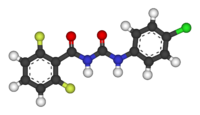
Photo from wikipedia
BACKGROUND Insecticide resistance in arthropods is an inherited trait that has become a major cause of insect pest control failure. Monitoring the level of susceptibility and characterization of the type… Click to show full abstract
BACKGROUND Insecticide resistance in arthropods is an inherited trait that has become a major cause of insect pest control failure. Monitoring the level of susceptibility and characterization of the type of resistance of key pest species aims to determine the risk of resistance selection in time to take actions to mitigate control failures. Seven populations of the boll weevil, Anthonomus grandis grandis, collected from cotton fields in the Semiarid and Cerrado areas of Brazil, were screened for their resistance to malathion and beta-cyfluthrin, insecticides widely recommended for control of boll weevil and other pests. RESULTS The levels of adult mortality were variable for beta-cyfluthrin (0-82%) but invariant (100%) for malathion. Bioassays of concentration-mortality were used to determine lethal concentrations (LCs) for each insecticide. The LC-values corroborate the lack of resistance to field rates of malathion but high levels of resistance to beta-cyfluthrin from 62.7- to 439.7-fold. Weevils resistant to beta-cyfluthrin were found through genome sequencing to possess a kdr mutation through the L1014F substitution in the voltage gated-sodium channel gene. CONCLUSIONS This study found boll weevil resistance to beta-cyfluthrin to be not mediated by carboxylesterases, but with cross-resistance to DDT and carbaryl, and kdr mutation as the major mechanism of the resistance in our samples. Caution is recommended in further use of beta-cyfluthrin against boll weevil due to potential resistance. Monitoring studies using other boll weevil populations are recommended to determine the geographic pattern and extent of pyrethroid resistance. This article is protected by copyright. All rights reserved.
Journal Title: Pest management science
Year Published: 2021
Link to full text (if available)
Share on Social Media: Sign Up to like & get
recommendations!